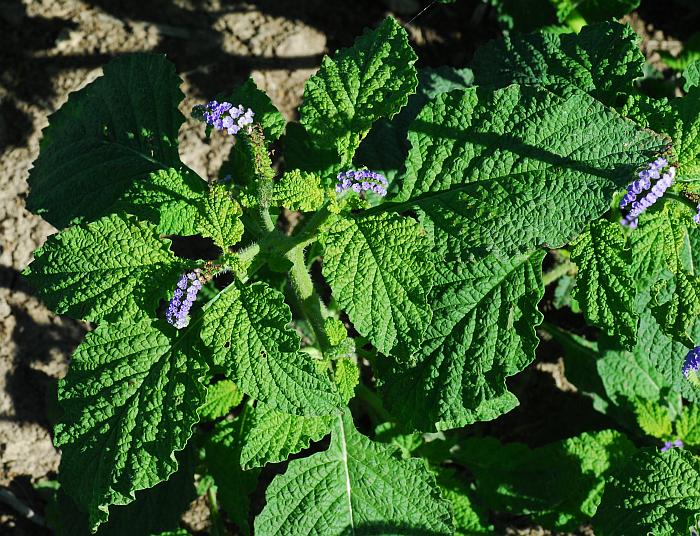Heliotropium indicum L.
Indian Heliotrope

Introduced
CC = *
CW = 0
MOC = 45
© SRTurner
Heliotropium indicum L.Indian Heliotrope | |
 |
Introduced CC = * CW = 0 MOC = 45 |
© SRTurner |
|
Family - Heliotropiaceae Habit - Annual forb, with slender taproot. Stems - Moderately ascending to erect, to 60 cm, usually branched, thick and hollow, sparsely to moderately pubescent with usually a mixture of longer, stiff, spreading, mostly pustular-based, nonglandular hairs and shorter, softer, spreading to loosely appressed, nonglandular hairs.
Leaves - Usually alternate toward the stem base and opposite above, sometimes all mostly alternate or opposite, moderately to long-petiolate, the petiole usually winged toward the tip. Leaf blades 4-8 cm long, 20-70 mm wide, herbaceous, broadly ovate to oblong-ovate or triangular-ovate, abruptly tapered at the base, angled or tapered to a bluntly or sharply pointed or rarely rounded tip, the margins entire to somewhat scalloped, wavy, or with a few coarse, blunt teeth, the surfaces rugose, sparsely to moderately pubescent with fine, short hairs mostly along the veins, sometimes also with sparse longer, bristly hairs along the main veins toward the leaf base.
Inflorescences - Terminal, solitary or rarely paired scorpioid spikes, these sessile or on a stalk to 2 cm long, densely flowered, lacking bracts.
Flowers - Calyces 1.5-3.0 mm long, the lobes linear to narrowly oblong-lanceolate, moderately to densely pubescent with stiff, loosely appressed, nonglandular hairs, more or less spreading after the fruit has dispersed. Corollas 2-4 mm long, 2-4 mm in diameter (measured across the spreading lobes), trumpet-shaped, blue to purplish blue, usually with a yellow to white spot in the throat, hairy on the outer surface, the tube 1-2 mm long, glabrous on the inner surface, the lobes 1.0-1.5 mm long. Stamens attached at the base of the tube, the anthers 0.5-0.8 mm long. Stigma on a short style, the sterile appendage short-cylindrical (about as long as wide) to slightly tapered, more or less truncate and minutely notched at the tip, glabrous.
Fruits - Dry and drupelike, 2.5-4.0 mm long, 3-5 mm wide, appearing strongly 2-lipped above a more or less globose body, with two divergent, flattened lobes at the tip, glabrous, splitting into 2 pairs of nutlets, these sometimes breaking apart with age into 4, 1-seeded nutlets. Nutlets with the dorsal surface having 1 or 2 prominent longitudinal ridges, light brown ventrally with greenish brown to yellowish brown lobes and dorsal surface.
Flowering - July - November. Habitat - Streambanks, pond margins, sloughs, crop fields, ditches, open disturbed areas. Origin - Probably native to tropical South America. Established in all tropical and subtropical countries on the planet. Lookalikes - None. Other info. - This attractive species occurs in Missouri mostly in counties south of the Missouri River. Its distribution within the continental U.S. mainly comprises a band from southern Missouri and Illinois down to the Gulf Coast, with more scattered populations extending eastward to the Atlantic Coast. The plant is easy to identify from its distinctive rugose leaves and curled inflorescences, which have blue flowers. Photographs taken along the shores of the Neusse River, Kingston, NC., 7-15-02 (DETenaglia); also at Otter Slough Conservation Area, Stoddard County, MO, 10-18-2017 and 8-7-2022 (SRTurner). |